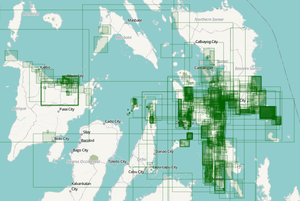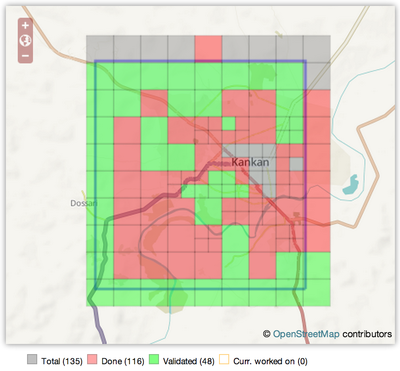2020 Beirut Port Explosion
For Aid Organizations
Map and Data Services

About OpenStreetMap
OpenStreetMap offers an online map (and spatial database) which is updated by the minute. Various tools and services allow data extracts for GIS specialists, Routable Garmin GPS data, Smartphone GPS navigation, and other device-compatible downloads. With an internet connection, regular syncing is possible with open access to the community contributed data as it comes in, with OpenStreetMap's bulk data downloads ideal for use offline. In addition, maps can also be printed to paper.
Browse the Activation Area to get a feel for the data that is currently available. Different map styles including an Humanitarian style can be selected on the right side, and some data may not render (appear) on the map, but could be exported from the underlying database (See export section below).
Paper Maps
Poster size Maps and normal sized paper atlases of custom areas can be printed:
- See OSM_on_Paper for an overview and list of platforms and services for printing maps.
- We suggest FieldPapers Paper Maps with grid for field survey or general navigation purposes.
Exporting OpenStreetMap data
See Downloading data for instructions on getting large scale map data, or see the focused exports below:
- A custom export can be made using the HOT Export Tool
- Regularly updated OpenStreetMap exports are available on the Humanitarian Data eXchange (HDX)
With the availability of Small communication devices, Navigation Offline data proves to be very useful to the humanitarians deployed in foreign countries. We support the humanitarian NGO's using navigation data and invite them to give us feedback on the utilization of these devices in the context of field deployment.
- See Software/Mobile for more information on using OSM in portable devices.
- See also Mobile Mapping on LearnOSM.org for information on mapping in the field.
About This Disaster Activation
About HOT

- To learn more about the Humanitarian OpenStreetMap Team (HOT), explore more of our wiki-pages (root: HOT) or our website hotosm.org. We are a global community of mostly volunteers, we are also a US Nonprofit able to contract with organizations (email info at hotosm.org to contact our staff), we are also a 501-c-3 charitable organization.
History of this Activation
Reactivity of the OSM Community
- August 4, 2020 - as soon as the event occurred and the local Lebanese OpenStreetMap community was able to secure a safe spot, updating the map of Beirut began. Prior to the incident a great deal of Beirut had already been mapped and the central area, including the port where the explosion occurred was already thoroughly mapped.
HOT Activates
- August 5, 2020 - Members of the Humanitarian OpenStreetMap Team (HOT) were hearing about the explosion and being notified via Twitter and other (mostly) social channels from late on August 4. As Activation Leads began to size-up the incident early on August 5th, immediate inspection revealed the area was well mapped and focus turned to identifying local community and establishing contact.
- By August 6, 2020 - the local mappers were completing the mapping of damage in the immediate vicinity of the explosion and starting to work on capturing 'street-view' (Mapillary) on their own. Contact among each other as well as with HOT was beginning to be established and both Planet Labs and MAXAR were releasing imagery under open licenses of the area post-event.
- August 9th - The Lebanese Red Cross, after determining verifiable damage had been reported as far as 24 kilometers from the epicenter of the explosion, makes a request of HOT to organize the mapping of Beirut out to roughly 8 kilometers away from the port. The mapping project is launched as well as the Ushahidi site developed by the local community. More details on these initiatives below.
- September 23 - Debriefing and After Action Review conducted. Concluding formal response.
Coordination
- HOT Coordinator(s): Russell Deffner, Toni Ros Martinez
- Local Lead(s): Marc Farra, Melda Salhab
Effort made
- After 10 days of mapping (Aug 8-18), 154 contributors have made 183,622 map changes including the addition of 21,119 buildings.
- In 17 days of mapping (Aug 8-25), 194 contributors have made 326,261 map changes including the addition of 36,166 buildings.
- In the first 4 Weeks (Aug 8-Sept 4), 220 contributors have made 516,553 map changes including the addition of 54,155 buildings (Source).
- September 1, contributors complete the initial mapping phase of project 9164 (see For Mappers section below).
- September 22 - Validation Complete
Collaborative Initiatives
- Open Map Lebanon is a community of local mappers that was created to help with mapping activities related to the explosion. Key activities include an Ushahidi crowdsourcing deployment, a street level imagery project using Mapillary, a 3D drone mapping project (in progress), collaboration with NASA ARIA to use SAR data to create a damage proxy map, and a needs assessment consolidation effort to help organizations collaborate. Details on select projects below.
- Ushahidi - Beirut Explosion is a platform designed for collecting needs and connecting resources.
- Mapillary is being used to collect 'street-view' imagery of the damage, in turn used by agencies and organizations to estimate damage and coordinate relief efforts. The images captured can also be used to help improve the mapping in OpenStreetMap.
For Mappers
- Thank You HOT Contributors! This response has concluded.
How You Can Contribute

Learn to Map
- Most of our volunteer needs are for remote OSM contributors, visit LearnOSM.org to get started.
Mapping Priority
- Please choose from highest priority first
- Experienced mappers are also asked to participate in validating completed tasks. Information on validating can be found here
| Project | Priority | Location | What to map | Imagery Source | Task Mapping Status | Task Validation Status |
|---|---|---|---|---|---|---|
| COMPLETE/ARCHIVED | ||||||
| Beirut Port Explosion 1 | Urgent | 8 kilometer radius | Buildings | MAXAR | Complete (100%) | Complete (100%) |
Available Imagery
OSM Default Imagery Sources
Maxar
Maxar Premium is generally available, minus a few cloudy spots, and is quite recent; use this as the general go-to imagery. The post-event imagery is more difficult to use due to offset and angle (off-nadir) though you are welcome to use it, see 'Alternative Imagery Sources' below for instructions.
Bing
Bing provides a global imagery data source that is the 'default' Imagery available for OSM (default option in most editors). Use this where MAXAR is cloudy.
Alternative Imagery Sources
How to add/use Alternative Imagery
In many cases better imagery is available than the default; when possible we set up a remote link directly via the Tasking Manager, so there is nothing to do, the iD editor and (as long as enabled) JOSM will automatically add the imagery.
Additionally, with JOSM, it's relatively easy to add special imagery if the license is appropriate for tracing into OSM. For more details see JOSM Imagery Help
